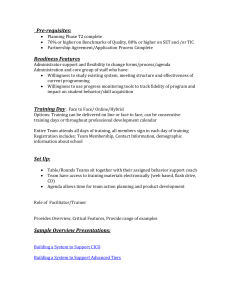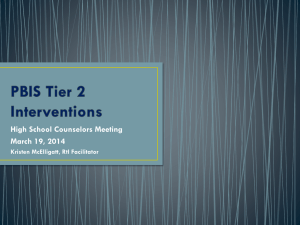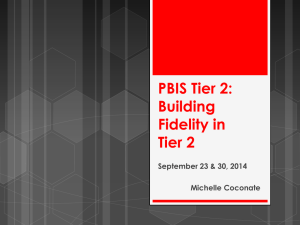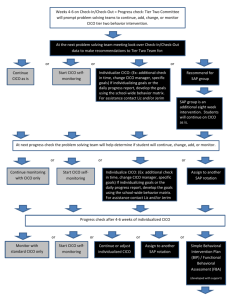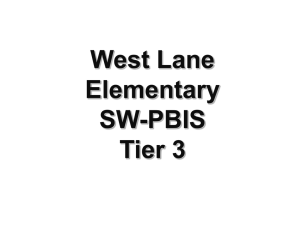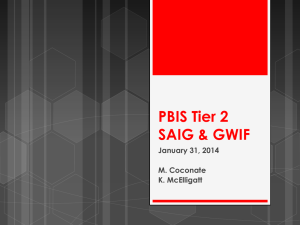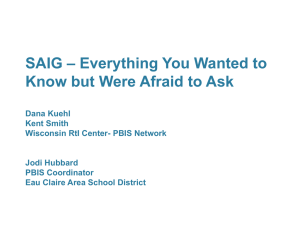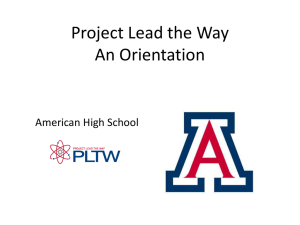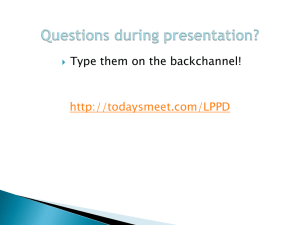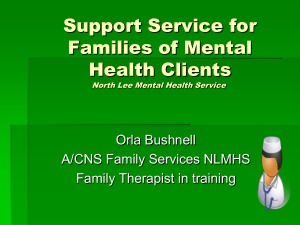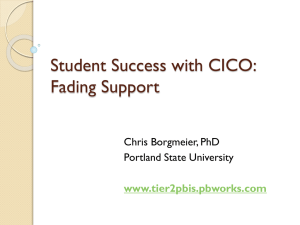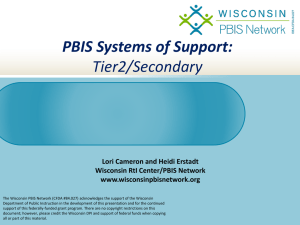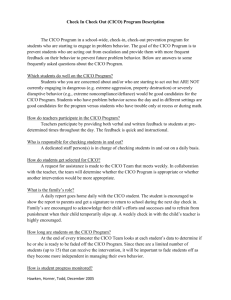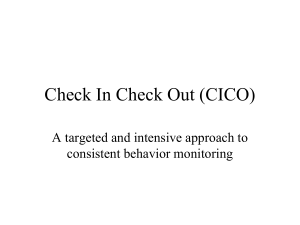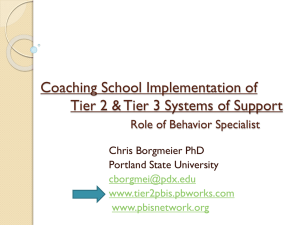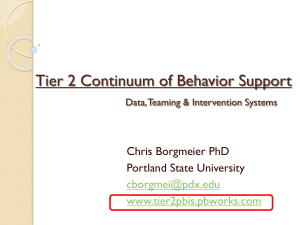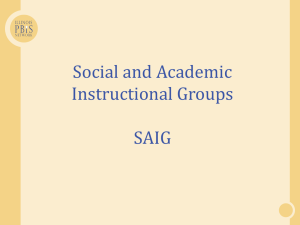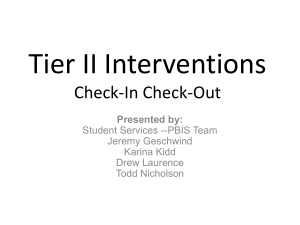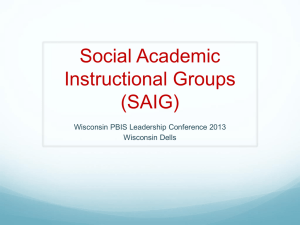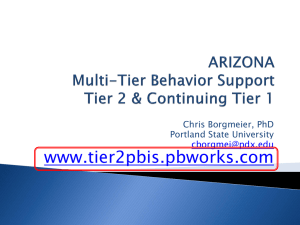SWIFT training - PBIS Maryland Home
advertisement
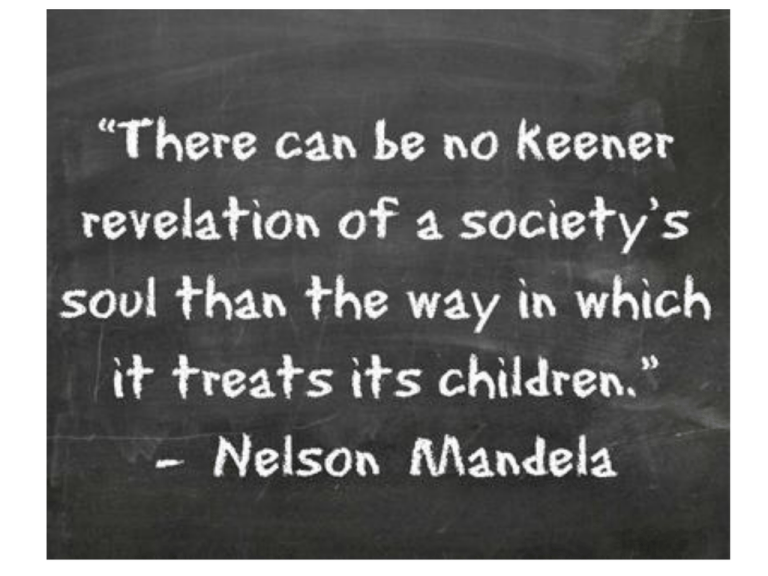
Building Tier 2 / Tier 3 Capacity Within A Multi-tiered (PBIS) System of Support PBIS MD Coach’s Meeting February 9, 2015 Patti Hershfeldt, Ed.D. Sheppard Pratt Health System Learning Expectations EXPECTATION BEHAVIOR BE RESPONSIBLE Make yourself comfortable Take care of your needs Tell us your questions BE RESPECTFUL Turn cell phones off or to “vibrate” Listen to others attentively Follow up on assigned tasks BE ENGAGED Share your passion Contribute to the team Have FUN!!!! Objectives • Critical features of advanced tiers – Overview – Problem solving • Identification of students – Data for selection, progress monitoring (student and intervention) – Knowing the students … • CICO + – SAIG – What else? Conversation: Critical Features 1. Intervention is continuously available 2. Rapid access to intervention (72 hrs) 3. Very low effort by teachers 4. Positive system of support 5. Students agree to participate 6. Implemented by all staff/faculty in a school 7. Adequate resources allocated (admin, team) 8. Continuous monitoring for decision-making Tier 2: Check-in-Check-out (CICO) • Merely an extension of Tier 1 • Some get high frequency scheduled positive contact with adults • Low effort for teacher if built on Tier 1 • Need to have 7-12% accessing if it is to come to be a routine in your school(s) • If you only have 1-2% on CICO, those are likely to be kids who need more…. Why do you want 7-12% on CICO? 5-7% of students in simple Tier 2 (CICO & SAIG Groups with ind. features) and here are some reasons why…. • Students in the past who would have gotten nothing (‘til they ‘got worse”) now get a positive boost of support • All teachers will expect that every day they will have kids cross their threshold who need higher rate of positive contact • Quicker/easier to support kids who need Tier 3 Conversation: Critical Features • Intervention is continuously available – What teaming structures do you utilize to place students in CICO? • Very low effort by teachers – • Positive System of Support – • What is the time commitment from the coordinator, team members...? Continuous monitoring for decision-making – • Dissemination of information about the intervention and securing adult feedback? Adequate resources allocated (admin, team) – • What role do students play in development, implementation, building sense of community? Implemented by all staff/faculty in a school – • Encouraging staff to support CICO by ensuring interaction w/students is 'positive and instructional'? Students agree to participate – • How do you promote buy in and participation from staff? (entering data, interacting with students..)? What data are collected, where are they stored, how consistent are DPRs completed, what challenges are faced having students carry DPR (and what accommodations have been made to address this)? Rapid access to intervention (72 hrs) 3-Tiered System of Support Necessary Conversations Family and community Universal Team Plans SW & Class-wide supports Universal Support Family and community Community Secondary Systems Team Problem Solving Team Uses Process data; determines overall intervention effectiveness Standing team with family; uses FBA/BIP process for one youth at a time Tertiary Systems Team Uses Process data; determines overall intervention effectiveness CICO Brief SAIG Group w. individual feature Brief FBA/BIP Sept. 1, 2009 Family and community FBA/ BIP Complex FBA/BIP WRAP Teaming at Tier 2 • Secondary Systems Planning ‘conversation’ – Monitors effectiveness of CICO, S/AIG, Mentoring, and Brief FBA/BIP supports – Review data to make decisions on improvements to the interventions – Individual students are NOT discussed • Problem Solving Team ‘conversation’ – Develops plans for one student at a time – Every school has this type of meeting – Teachers and family are typically invited Tier 2 Team Roles Roles Needed: Who can fill these roles? • • • • • • • • • • Team leader CICO coordinator Action plan recorder Time keeper Family Representative Community partner General Education Teachers Special Education Teachers Paraprofessionals Special teachers (music, PE, librarian, etc) • School Counselors, Social Workers, psychologists Conversation: Critical Features • • • • Intervention is continuously available – What teaming structures do you utilize to place students in CICO? Very low effort by teachers – How do you promote buy in and participation from staff? (entering data, interacting with students..)? Positive System of Support – Encouraging staff to support CICO by ensuring interaction w/students is 'positive and instructional'? Students agree to participate – • Implemented by all staff/faculty in a school – • What is the time commitment from the coordinator, team members...? Continuous monitoring for decision-making – • Dissemination of information about the intervention and securing adult feedback? Adequate resources allocated (admin, team) – • What role do students play in development, implementation, building sense of community? What data are collected, where are they stored, how consistent are DPRs completed, what challenges are faced having students carry DPR (and what accommodations have been made to address this)? Rapid access to intervention (72 hrs) Conversation: Critical Features Directions for table activity • Establish recorder and a reporter • Independently think about the assigned feature & topic specific to your school. • On an index card, jot down your school-specific thoughts • Share at your table, record, and be prepare to report out • Share with larger group – Use ‘table activity’ sheet to capture ideas Conversation: Critical Features Conversation: Critical Features Action Plan • Given what we’ve learned about Critical Features what do you feel is missing (or needs strengthening) in the implementation of Tier 2 at your school? • Reflect on the Action Plan • Consider: As coaches, how will you disseminate this back at school? Student Identification: Data for selection and progress monitoring Data-Based Decision-Making 1) Student outcome data is used to: Identify Students Progress Monitor “In” “On” Transition “Out” Student Identification • Considerations: – How will students be identified? – What are the decision rules? – Students should be able to access support in multiple ways Data Decision Rules WHY? • We need to know when a student(s) requires additional support or no longer needs support • Decision making points will assist teachers to indicate need as it occurs • Provides a formalized system for teachers to make decisions quickly and effectively Conversations…. • What data point (s) take priority? • What role does your profession play when establishing data rules for access? • What role do local issues, SIP, goals play? • What data points will you set to structure access to advanced tier (more intense) supports? Guiding Questions What are the Tier 1/Universal data sources used to identify this need (i.e. SWIS, Universal screening, attendance, grades etc.)? Note: Multiple data points are necessary for a comprehensive school-wide system of identification, however, each youth does not necessarily need more than one data point to be identified for support. Data-based decision rules for identification: 1) Data source #1: ______________ Rule for Inclusion in Intervention: ____________________ Time frame: ______________ 2) Data source #2: ______________ Rule for Inclusion in Intervention: ____________________ Time frame: ______________ 3) Data source #3: ______________ Rule for Inclusion in Intervention: ____________________ Time frame: ______________ ** Teacher/Family Request for Assistance enters youth (circle one): Yes No Decision Rules for Access to Advanced Tiers and decision rules for preventionif we can predict the trajectories, then we can prevent it from happening • • • • • • • • • • • • student has 2 Major Office Referrals student has 1 Suspension student experiences more than ? minutes out of instruction student misses more than ? days unexcused absences student drops GPA by more than ?? student – benchmark testing student- incomplete class work/homework Attendance (look at predictors for drop-out and school completion) Admin Referral Teacher/Staff Referral Family Referral Other: Progress Monitor • Student progress – 80% of points • Effectiveness of the intervention – 70% of students responding Student Identification: Early Warning System http://www.betterhighschools.org/ews.asp Data-Based Decision-Making 2) Intervention Integrity or Process Data is used: To monitor the effectiveness of the intervention To make decisions regarding the continuum of Interventions Is monitored by the Tier 2 Systems Team Intervention Integrity data Data-Based Decision Making Numbers to Keep in Mind • 80-90%: Percent of total population whose needs will be met by only Tier 1 • 5-15%: Percent of total population expected to need and be supported by Tier 2 interventions • 7 -12% could be supported in CICO • 1-5%: Percent of total population expected to need and be supported by Tier 3 interventions • 70%: Percent of youth (receiving intervention “X”) that should be responding to intervention • Data-based Decision-Rules for ‘determining response’ must be defined – Data sources defining response are efficient • Ex. Daily Progress Report (DPR) cards: Student maintains an 80% average on DPR for 4 weeks Knowing Students … “The One Pager” Name: Address: DOB: Date: My Strengths My Interests My Preferences My Needs Name: Sydney Address: DOB: You’re Invited (IEPMeeting) Date: Time: My Strengths • I am learning how to deal with my stuttering • I am making changes in my breathing and how I talk Interests *I like to hunt *I like to ride my golf cart *I like to play with my brother Preferences • Please do not talk about my speech! Needs • Help from speechlanguage pathologist Hey I’m Robert. I’m 14 no I’m just joking. I’m really 12. Have great time reading this. I have an IEP because … I have anger issues I need to control it and not get angry over little things and not get frustrated. My Interests: I like to play star wars games and draw Ways to learn best: Skip some problems and go to next one until I can get it. Read the question first then read the story. My favorite classes: L.A because I love The word ladder P.E because I like to play games My plans for the future: Go to Virginia Tech college. Be a game designer . Buy my own house. Start a basic job before I be a game designer. My hardest classes: Math because division and multiplication have a lot of thinking Social studies because all the writing and highlighting. Tier 3 Individual students sends one to all teachers prior to school year starting Use to inform POP at IEP meeting Tier 2 CICO Coordinator provides copy to ‘mentor’ ‘Mentor’ uses one-pager to get to know student Tier 1 Triangle Activity: Applying the Three-Tiered Logic Entire 9th grade class during 1st week of school (PE class) Complete in 5th and 8th grade to help w/transition Knowing Students.. Table Activity • How else could you use this activity? • What benefits would an activity like this serve? Teresa Cogar & John McNaught Virginia Department of Education www.imdetermined.org Social and Academic Instructional Groups (SAIG) Some students may need more… • Use data and reverse request for assistance to determine what the next layer should be • Continue “CICO System” but add social or academic instructional group • Use Tracking Tool to determine success criteria, monitor progress Social Academic Instructional Groups • Three types of skills-building groups: 1) Pro-social skills 2) Problem-solving skills 3) Academic behavior skills • Involves use of Daily Progress Report (DPR) Card • Currently, these are often the skill groups facilitated by Social Workers, Counselors, and Psychologists Social Academic Instructional Groups Three types of skills-building: 1) Pro-social skills (replacement behaviors for avoidance, withdrawal, etc.) Friendship Skills/Social Awareness/Relationship Building 2) Problem-solving skills (replacement behaviors for fighting, arguing, etc.) Conflict Resolution Skills/Anger Management Skills/Self Management 3) Academic Behavior skills (replacement behaviors for getting out of seat, poor study habits, talking out during instruction, etc.) Study/Organizational Skills/Focus/SelfManagement Skills/Responsible Decision-Making Intervention includes structured prompts for what to do in relevant situations 1st block EXPECTATIONS 2 Be Safe Use your words Use deep breathing Be Respectful Keep arm’s distance Use #2 voice level when upset Be Responsible Ask for breaks Self-monitor with DPR Total Points Teacher Initials 1 2nd block 0 3rd block 4th block 2 1 0 2 1 0 2 1 0 2 1 0 2 1 0 2 1 0 2 1 0 2 1 0 2 1 0 2 1 0 2 1 0 Daily Progress Report (DPR) Sample NAME:______________________ DATE:__________________ SAIG Problem Solving Skills Teachers please indicate YES (2), SO-SO (1), or NO (0) regarding the student’s achievement to the following goals. 1 st block EXPECTATIONS 2 Be Safe Use your words Use deep breathing Be Respectful Keep arm’s distance Use #2 voice level when upset Be Responsible Ask for breaks Self-monitor with DPR 1 2 nd block 0 3 rd block 4 th block 2 1 0 2 1 0 2 1 0 2 1 0 2 1 0 2 1 0 2 1 0 2 1 0 2 1 0 2 1 0 2 1 0 Total Points Teacher Initials Adapted from Grant Middle School STAR CLUB Adapted from Responding to Problem Behavior in Schools: The Behavior Education Program by Crone, Horner, and Hawken SAIG Academic NAME:______________________ DATE:__________________ Behavior Skills Teachers please indicate YES (2), SO-SO (1), or NO (0) regarding the student’s achievement Daily Progress Report (DPR) Sample in relation to the following sets of expectations/behaviors. 1 st block 2 nd block 3 rd block 4 th block EXPECTATIONS 2 Be Safe 1 0 2 1 0 2 1 0 2 1 0 Walk to class Keep hands to self Be Respectful 2 1 0 2 1 0 2 1 0 2 1 0 2 1 0 2 1 0 2 1 0 2 1 0 Be on time Raise hand to speak Be Responsible Bring materials Fill out assignment notebook Total Points Teacher Initials Adapted from Grant Middle School STAR CLUB Adapted from Responding to Problem Behavior in Schools: The Behavior Education Program by Crone, Horner, and Hawken Packaged Behavior Lesson Plans • • • • • • • • • Second Step (Grades PreK-8) Thinking, Feeling, Behaving (Grades 1-12) Tough Kids Social Skills (Grades 3-7) Walker Social Skills Curriculum (Grades 6-12) Skillstreaming (Grades PreK-12) Stop & Think Social Skills (Grades PreK-8) Passport (Grades 1-12) I Can problem Solve (Grades PreK-6) Aggression Replacement Training All of above examples could be used to develop universal behavior lesson plans. Create Your Own Lesson Plans: Teaching Behavioral Expectations • • • • • State behavioral expectations Specify observable student behaviors (rules) Model appropriate student behaviors Students practice appropriate behaviors Reinforce appropriate behaviors Example SAIG Facilitators Teacher’s Aide Classroom Teachers Librarians Secretaries Volunteers Local Community Partners Conversation: Critical Features 1. Intervention is continuously available 2. Rapid access to intervention (72 hrs) 3. Very low effort by teachers 4. Positive system of support 5. Students agree to participate 6. Implemented by all staff/faculty in a school 7. Adequate resources allocated (admin, team) 8. Continuous monitoring for decision-making Thank you…
